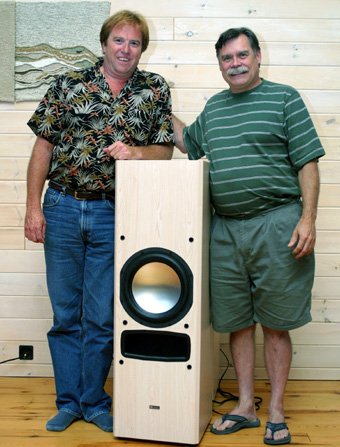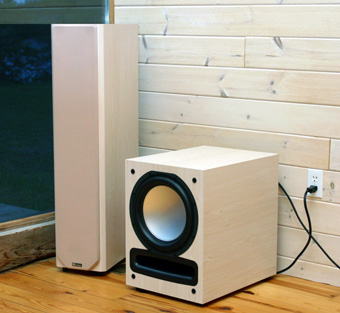![[SoundStage!]](../sslogo3.gif) The Traveler The TravelerBack Issue Article |
|||
September 2004 Summer Thunder: Axiom's New Subs Scale New Heights to Reach New Depths
I first visited Axiom Audio’s headquarters in 2000 -- a year that wasn't just the rollover to a new millennium but the company's 20th anniversary as well. There was a celebration -- a barbecue to be exact, for the anniversary not the Y2K thing. Since that first trip, my visits to Axiom have been an annual affair that usually take place in the summer. The Muskoka region is absolutely gorgeous -- sprawling lakes amidst endless scenery. Not surprisingly, with beauty in abundance, it’s a resort-type location where you’ll not only find plenty of hotels, motels, and cabin-based resorts, but also megabuck houses that some call their "summer home." Shania Twain has a couple of massive houses across the lake from Ian Colquhoun’s house, Axiom’s owner. Ian’s house isn’t his summer home, though, but rather the year-round home that he shares with his wife, Amie. His factory is set up in this beautiful but somewhat remote region. Ian was born and raised in the area, and he built his company in this far-off place without succumbing to the temptation of heading to the "big city." To most, that’s like sticking your company in the middle of nowhere -- nowhere with megabuck houses, anyway. Yes, the Muskoka region, despite the tourists, trees, lakes, and the lavish summer homes, is a pretty secluded spot. But Colquhoun flourished nonetheless, and Axiom became quite a successful speaker brand. And when the Internet came along a decade and a half after he started his company, he flourished even more. Today I’d rank Axiom Audio as the most successful Internet-direct speaker seller on the planet -- so successful, in fact, that my annual trips to Muskoka have become more or less annual mini-events during which Axiom unveils their latest creations.
Last year they presented a new cable lineup along with custom-color options for all their speaker models. The year before I saw their new in-factory listening room designed to do blind-listening tests for subjective evaluation of all the products. This year it was two new subwoofers -- dubbed EP500 and EP600 -- which, if they deliver all that Axiom says they can, may well take the home-audio and home-theater markets by storm when they’re released this month. From what I could see and hear, they're something. Colquhoun does things differently -- that's why his company is where it is and sells the way it does -- and he likes to do things to extremes as well. That’s precisely what the EP500 and EP600 are about -- subwoofer technology with some entirely new thinking that appears to deliver rather extraordinary results. Colquhoun wasn't content with response to just 30 or 40Hz. He wanted flat-as-a-pancake response to 20Hz, or lower, which he got. Intrigued? Let me pull some Memento on you and tell you the ending before getting to the beginning. During my visit Colquhoun showed me frequency-response graphs for the EP500 and EP600, and my eyes opened twice as wide. The EP500 is flat to 20Hz under anechoic conditions. Flat, as in plus or minus maybe 2dB from about 100Hz down to 20Hz (actually, in a phone conversation that I just had with Ian, he said "plus or minus 1.5dB"). And let me reiterate the words anechoic conditions -- that means flat in free space, without room reinforcement. To those who don’t understand the numbers and terminology, that’s staggeringly deep. The EP600 is said to be flat to 16Hz! Low end like that, though, doesn't come easily. Back last year when I was looking at the new cables and the collage of custom speaker colors, Colquhoun showed me a prototype of a new sub. It was huge -- taller than the refrigerator it happened to be standing beside when I saw it (I'm not kidding). These new subs aren’t that big, but Ian figured out by playing with this prototype that he’d have to make his new subs pretty big if he wanted them to go plenty deep. At about the same time Ian hired Tom Cumberland -- an expert in electronics design. Along with Peter Bobyk, one of the company’s design engineers, the Axiom Audio brain trust came together and out came the EP500 and EP600 -- which do what they do with a mixture of conventional speaker design along with cutting-edge digital signal processing. In a nutshell, the subs digitize the incoming analog signal, and in the digital domain manipulate the signal to be ruler-flat and as extended as possible. That's why these new subs are somewhat smaller than that prototype but can go deeper, play louder, and display less distortion. They look fairly straightforward, but inside they're pretty remarkable. Designing digitally also allowed Axiom to do things that would be otherwise impossible in the analog domain. For example, because the signal’s been digitized, the upper-end frequency limit of the subs can be shelved off dramatically -- gone like the many flies and other insects that hit my windshield as I drove through the forested areas on the way to Ian’s house. That makes mating the subs to speakers much easier. Also, because the signal’s being manipulated digitally, the designers tell me that they can make the woofer perform just the way they want without "analog-type" problems, such as phase shift and the like. The digital manipulation is also why the subwoofers are purported to be unbreakable. The software "knows" the limits of the subwoofer. If you put a signal in that would cause damage, the software inside will figure that out and simply adjust to keep the subwoofer safe. That "thinking" inside the sub also helps to eliminate another nasty audio problem: distortion. The sub’s always analyzing the signal it’s passing through and adjusting accordingly to keep the driver performing cleanly. And lest you think that the software limits the sub's ability to play at high levels, think again. Anyone who knows Ian knows he likes to play his music the way he designs and does other stuff -- to extremes. With the assistance of their internal power amplifiers, the EP500 and EP600 can play to extraordinarily loud levels cleanly and clearly, something I’ll get to in a moment.
The EP500 and EP600 share a lot of common parts, like the single 12" driver, and they both have the same amplifier technology -- a hybrid digital-switching design that features an analog power supply. Ian said that they designed the amp this way, and not as a purely digital amp, because digital amps "don't have dynamics, and these ones do." The difference is the power: the EP500's amp puts out about 500W, while the EP600's amp delivers, not surprisingly, 600W. The EP500 is more conventional-looking, with a rather blocky appearance, making it appear not all that different from subs from quite a few other companies. The EP600, though, is twice the size, but instead of keeping the blocky appearance and just making it bigger, Axiom opted to extend it upwards. As a result, the EP600 looks like a rather tall, wide, deep floorstanding speaker. The EP600 also retains the "side-sloped" cabinet design that Axiom speakers have, where the front baffle is considerably wider than the back. That design makes the EP600 sub, like the rest of Axiom's speakers, look less "boxy." Techno-babble, obviously, only tells you so much. The proof is always in the listening. So, from the factory, Ian and I headed to his lakefront home where he has a complete Axiom system set up, comprising M80ti front speakers, a VP150 center-channel, and QS8 surrounds. He was using both subs. The EP600 was augmenting the M80ti front speakers; the EP500 was filling in the bottom end for the center-channel and surrounds. First I played the soundtrack to the movie Gladiator [Decca 467094], mostly to see how loud and deep the subs could play, and how much air the woofers would move. Wow, talk about excursion! During the loudest passages the sound was ear-splitting, and the woofers were moving so much that I thought they were trying to reach out and shake me. However, they didn’t give in, or even hint that they would. The sound was ultra deep, extremely loud, and exceptionally clean. Next I played the opening track from Greg Keelor’s Gone [Warner Canada 17513]. The very beginning has deep bass that's perfect to test a subwoofer because with many speakers I hear truncated bass accompanied by other sounds. Frankly, I never knew what those other sounds were, and I’ve wanted to find out for some time. Now I suspect they are distortion, but not distortion within the recording, as I originally surmised. Playing this cut on Ian's system, the only sound accompanying the deep bass was rattling -- of cupboards and pictures from the bass waves that shook the house. Otherwise, everything down low was clean, clean, clean. But great subwoofers don’t just make for a more enjoyable experience on tracks like these that have show-and-tell-type bass. Next I pulled out Tupahn’s Covered Treasures [SPMX 1003], which really is a treasure, with Brazilian guitarist Tupahn covering such classics as "The Boxer," Stairway to Heaven," "Hotel California," and others. All the tracks are mostly just his guitar, so the arrangements are pretty sparse, but he augments some tracks with an additional guitar or a simple drum track. Given the simplicity of the disc, and despite the fact that it was recorded in bargain-basement fashion, it sounds very good, and the musicianship is outstanding. Tupahn mesmerized all of us in Ian's room for the length of the album -- we listened to it all straight through, forgetting, for the most part, that we were evaluating sound, too. Still, at the end of it we all knew one thing about the sound: the subs were blending seamlessly with the main speakers. There was no discontinuity whatsoever, one of my gripes with many speaker systems that include a subwoofer. I suspect that's why we could forget about critiquing and simply do so much listening. The subs sounded spectacular with music, but we never actually watched (or listened, rather) to any movies over Ian's system. We just didn’t have time. Still, the way the subs played the Gladiator soundtrack makes me think that they’ll have no trouble with movies whatsoever. However, we’ll let our Home Theater & Sound staff have the last word on that. During my visit I specifically asked for review samples to be sent there as soon as they’re available. "Soon," Ian and Amie said. When released, the EP500 and EP600 will be the most expensive products that Axiom makes. The EP500 will cost $1150 USD and the EP600 $1750. Axiom's top-of-the-line M80ti speakers sell for just $1100 per pair. But that doesn’t mean these new subs aren't good values. With the amount of technology that Axiom’s packing inside, I think the company may well again be running at the forefront of value and performance. For example, Ian pulled out a frequency-response chart of Axiom's M60ti speakers ($800 per pair) married to an EP500 sub. The M60ti measurement he showed me illustrated that the speaker was very flat on its own, but rolled off far above 20Hz. A M60ti/EP500 loudspeaker system could reproduce what's known in audiophile circles as "truly full-range sound" -- 20Hz to 20kHz -- and is priced just under $2000. As with last year, this year’s visit to Axiom was full of cutting-edge surprises. What will they have in store next year? From what I could tell from this visit, there will certainly be something. Rumor has it that Axiom’s now looking into producing electronics, but as Tom and Ian said to me at one point during which I was asking too many questions, "It’s a little too early to talk about that." Maybe next year. ...Doug Schneider
|
|||
|
|||
![[SoundStage!]](../sslogo3.gif) All Contents All ContentsCopyright © 2004 SoundStage! All Rights Reserved |



